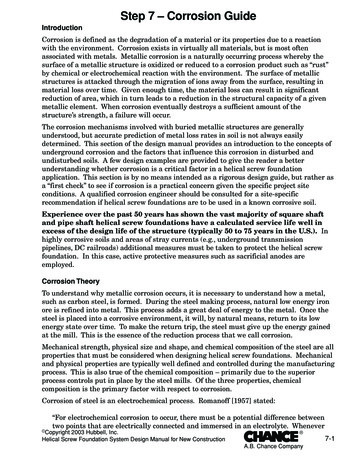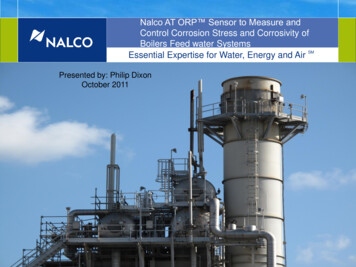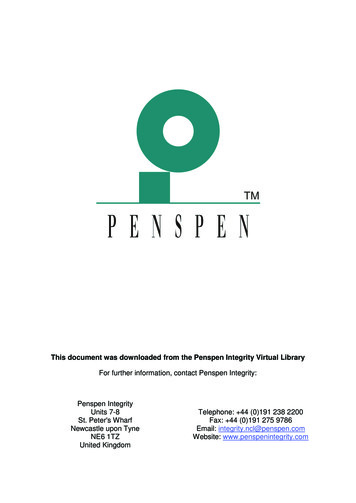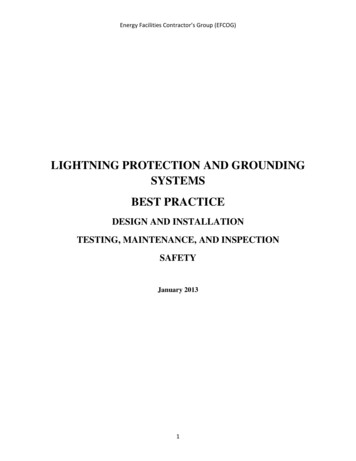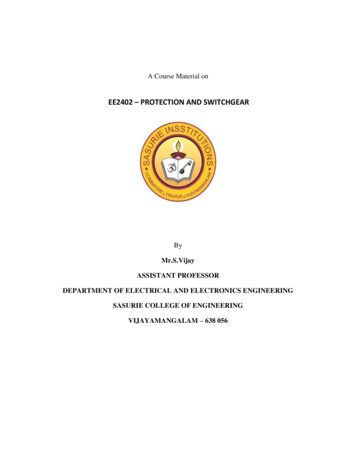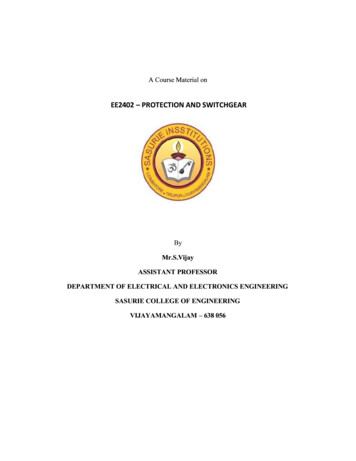
Transcription
Handbookfor Corrosion Protectionof Steel Surfaces by Painting
Handbookfor Corrosion Protectionof Steel Surfaces by Painting
2013, Teknos Oy (Second Edition)Publisher: Teknos OyLayout design: Mainostoimisto Dynastia OyPrinters: Offsetpaino Tuovinen KyAcknowledgements:Pinteco Oy (Elcometer)Tallberg Roboma Oy Ab (DeVilbiss, Ransburg, Binks)S.O. Strömberg Oy (Byk)Photographs on the inside covers:Sandvik Mining and ConstructionAvant TecnoPonsseVRNormek, Sonera StadiumRuukki, Swedbank StadiumNeste OilWinWind4
Corrosion protection by paint systemsPaints are liquid or powdery substances that are applied in thin coats on a substrate using a paint applicationmethod. The paint dries into a solid coating which bonds to the substrate.The painting of metal substrates with protective paint systems is called corrosion protection painting.The purpose of corrosion protection painting is to protect the metal substrate against atmospheric corrosivity, i.e.rust, and to give the surface the designed appearance and texture.Corrosion protection painting is a process where quality cannot be fully assessed merely based on the acceptance inspection of the finished coating. Therefore, it is imperative that the process of corrosion protectionpainting is planned carefully. It is equally important to manage and monitor all parameters affecting the coatingoutcome during the painting process.Teknos has compiled this handbook to provide clients, designers, employees and students with optimally comprehensive information on corrosion protection painting.We hope that you will find this handbook useful.Yours faithfully,TEKNOS OY5
Corrosion protection painting1. PROTECTIVE PAINTING AS CORROSION PROTECTION METHOD.9Introduction.9Corrosion mechanism in metals .9Protection mechanism of paint systems.10In conclusion.102. PRIMARY STANDARDS ASSOCIATED WITH CORROSION PROTECTION PAINTING.11Standardisation.11EN and ISO standards.113. PLANNING OF CORROSION PROTECTION PAINTING.16Prerequisites for good corrosion protection painting.16Painting as design consideration for steel structures.16Determination of application site for corrosion protection painting.174. SUBSTRATE PREPARATION.18Determination of preparation method and the quality grade for metal working and surface preparation.18Removal of grease and soil.18Rust removal.18Determination and assessment of cleanliness and surface profile of steel surface.19Rust grades.19Preparation grades.19Grading of blast-cleaned steel surface profile.20Prefabrication primer treatment.22Preparation of galvanised surfaces.22Chemical conversion treatments and etching primers.235. PROTECTIVE PAINT SYSTEMS.25Composition of paints.25Paint types.26Reversible coatings.26Irreversible coatings.26Air curing paints (oxidation).26Water-borne dispersion paints (one-pack).27Chemically curing paints.27Two-pack epoxy paints EP.27Two-pack polyurethane paints PUR.27Oxirane ester paints. 28Moisture curing paints.28Stoving paints.28Powder coatings.28Coil coatings.286. PAINT SYSTEMS.29Markings of the paint systems.29Determination of the paint system.30Corrosivity categories.30Preparation and application conditions.30Economical considerations.306
7. EXECUTION OF PAINT WORK.31Painting methods.31Brush application .31Roller application.31Spraying.31Dipping.37Application conditions .37Relative humidity and dew point.37Effect of ambient temperature on curing.40Film thickness and associated measurement.40Film thickness.40Measurement of wet film thickness.40Measurement of dry film thickness.41Non-destructive methods.41Destructive methods.42Calculation of paint consumption.43Tables for estimation of paint consumption.448. QUALITY CONTROL OF CORROSION PROTECTION PAINTING.45Quality plan.46Targets of quality assurance.46Personnel.46Steel structure.47Surface preparations.47Conditions.47Application methods, tools and implements.48Substances used in paint work.48Application.48Finished coating.48Inspection tools and implements.49Reference areas.49Documentation of paint work and conditions.49Documents existing prior to commencement of paint work.49Documents issued during paint work.49Inspection records.499. MAINTENANCE PAINTING.51Evaluation of coating degradation.51Time for maintenance painting.51Determination of the maintenance paint.52Execution of maintenance painting.5310. OCCUPATIONAL SAFETY GUIDELINES APPLICABLE TO PAINT WORK.5411. LIST OF STANDARDS.5612. PAINTING PROBLEMS – TROUBLESHOOTING.6013. FUTURE OF CORROSION PROTECTION PAINTING.63FORMS .657
8
1. Protective painting ascorrosion protection methodIntroductionVarious engineered materials used for industrial purposes require protection against the effects of the environment. These materials comprise concrete composites and a number of different metals, for example. Concrete substrates need coating against carbonatisation and surface disintegration due to abrasion, among othersthings. Metals need protection against corrosion.Corrosion is a physicochemical reaction occurring when a metal is exposed to its environment, which changesthe properties of the metal and, in many cases, results in degradation of the metal, adjacent environment ortechnical system.Rust is reaction product of iron and steel corrosion.Corrosion damage is any change in the corrosion system due to corrosion and which is considered to causedegradation of the metal, the adjacent environment, or the technical system they constitute together.Corrosion system comprises one or multiple metals and all of the parameters of the environment, which contribute to corrosion. Such parameters of the environment can also be the coating surface layer, electrode, and soforth.Anti-corrosion or corrosion protection refers to the modification of the corrosion system in a way that retards orinhibits the formation of corrosion damage.Corrosion protection painting refers to the coating of metal surfaces with corrosion protection paint.Corrosion mechanism in metalsMetal corrosion is currently explained by the formation of local electrochemical electrode pairs on the metal surface. The electrode pair is called an anode-cathode pair. Positive metal ions are dissolved from the anode to thesolution, and produce negative electrons in the metal lattice, which migrate in the metal to the cathode. In thecathode, the electrons are consumed in multiple cathode reactions. In acid solutions, hydrogen gas is produced,while in pH neutral solutions oxygen reduction produces hydroxide ions. The electrically conductive electrolytebetween the anode and cathode closes the circuit. The anode and cathode sites can be next to one another,resulting in the formation of uniform corrosion or separated from one another resulting in localised corrosion. Theanode site is the metal surface’s less noble site or a site with a higher surface energy. Image 1.1 illustrates theformation of local pairs onto a metal surface, and the anode and cathode reactions.Local corrosion pairs(-) anodeFe – Fe2 2e( ) cathode2H 2e- – H2O2 2H2O 4e- – 4OH-Image 1.1 The formation of local pairs onto a metal surface, and the anode and cathode reactions.9
Combining the anode and cathode reactions provides the total reaction:Fe2 2OH- – Fe(OH)24Fe(OH)2 O2 – 2H2O 2Fe2O3*H2O hydrous iron oxide, i.e. rustThe corrosion protection mechanism in metal is based on- the inhibition of formation of local pairs on a metal surface, and- the inhibition or retardation of anode and/or cathode reactionProtection mechanism of paint systemThe overwhelmingly most popular corrosion protection method is the application of paint onto the metal surface.An impervious, intact and sufficiently thick coating will prevent ions from entering the metal surface, thus reducing the formation of local pairs. Epoxy paints provide an example of a type of paint based on imperviousness.Corrosion protection paints used against atmospheric stress utilise corrosion protection pigments, which retardthe dissolution of metal ions from the anode sites. Various phosphates and borates, for example, are used ascorrosion protection pigments, which, together with water entering the coating, form protective layers at theanode sites.The paint protects the steel surface cathodically, when it contains sufficient quantity of zinc dust. The zinc particles in the coating are in electrically conductive contact with the steel substrate, and, as electronegative metals,are sacrificial anodes that inhibit steel corrosion.Water-borne paints also utilise corrosion inhibitors to inhibit corrosion during paint application or curing (flashrust).In conclusionCorrosion of the metal surface to be protected can be inhibited or retarded by applying:- corrosion protection paint containing corrosion protection pigments, which passivates the anode and/orcathode reaction, or- a coating, which generates sufficient resistance against an ion current- a primer giving cathodic protection10
2. Primary standards associatedwith corrosion protection paintingStandardisationThe purpose of standards is to promote trade and industry, increase safety, welfare and consumer protection aswell as to facilitate domestic and cross-border commerce.Pursuant to standard EN 45020, the standard resulting from standardisation work is defined as follows:‘A standard is a normative document, established by consensus and approved by a recognised body, that provides for common and repeated use, rules, guidelines, or characteristics for activities or their results, aimed at theachievement of the optimum degree of order in a given content’.A standard is usually a recommendation only. In certain cases, public regulatory bodies may reference the standards in the regulations and directives. These so-called reference standards or normative standards are legallybinding documents.In Finland, the Finnish Standards Association SFS and its member industry bodies draft and issue the standards.Public bodies and professional, commercial, and industrial organisations take part in the drafting work. Standards drafting focuses currently on European (EN) and international (ISO) standards.The Finnish standards relating to paints and coatings are drafted by the following SFS member organisations:- Chemind, Chemical Industry Federation of Finland, Kemianteollisuus ry- MetSta, Metalliteollisuuden Standardisoimisyhdistys rySFS endorses, issues and sells both Finnish and international standards. SFS also provides and disseminatesinformation on standards and statutory regulations.The standards relating to the planning and execution of painting work are a result of a long-term and systematicdrafting effort. The standards provide users of paints all over the world with detailed information and knowledgeof the relevant environment, structure, substrate, paint or paint work in any given situation.EN and ISO standardsEuropean Union member states constitute an internal market aimed at the free mobility of goods and services.Ensuring free mobility of goods requires harmonisation of the various technical standards of the member states.The international standard EN ISO 12944 on corrosion protection of steel structures by protective paint systems,approved and adopted on 25 May 1998, is one further step toward this end.ISO 12944 consists of the following parts:Part 1 General introductionPart 2 Classification of environmentsPart 3 Design considerationsPart 4 Types of surfaces and surface preparationPart 5 Protective paint systemsPart 6 Laboratory performance test methodsPart 7 Execution and supervision of paint workPart 8 Development of specifications for new work and maintenanceDurabilityDurability is indicated in ISO 12944-1 in terms of three ranges:2 to 5 yearslow (L)5 to 15 yearsmedium (M)more than 15 yearshigh (H)The durability range is not a “guarantee range”. Durability is a technical consideration that can help the owner setup a maintenance programme. A guarantee period is a major issue, and is subject to dedicated clauses in thecontract. The guarantee time is usually shorter than the durability range. There are no rules that link these twoperiods of time.11
Classification of environmentsAtmospheric corrosivity and special corrosion stresses influence the durability of the structure’s corrosion protection painting and the planning of paint work in an important way.Pursuant to ISO 12944-2, atmospheric corrosivity is divided into six categories:C1very lowC2lowC3mediumC4highC5-Ivery high (industrial)C5-M very high (marine)The classification is based on the corrosion rate of steel and zinc during the first year in exposure.ISO 12944-2 defines three corrosivity categories for structures immersed in water or buried in soil:lm1immersion in fresh water, such as structures in rivers, hydropower plantslm2immersion in sea or brackish water, such as port structureslm3burial in soil, such as subterranean containers, steel beams and similar structuresStructure and surface preparationISO 12944-3 provides instructions for the design of structures intended for coating.ISO 12944-4 discusses a number of different substrates and surface preparation methods. In the definition ofsurface preparation methods and preparation grades, the standard references the following existing ISO standards: ISO 8504 Surface preparation methods, ISO 8501 Rust grades and preparation grades, and ISO 8503Method of grading surface profile.Paint systemsThe protective paint system is composed of the substrate, surface preparation, and the combination of paintsused for coating.ISO 12944-5 presents the most common types of corrosion protection paints and protective paint systems.The markings for the paint types are:AcrylicAlkydEpoxyChlorinated rubberPolyurethane, aliphaticPolyurethane combinations, purified urethane tarEthyl zinc silicateEpoxy zincPolyvinyl chlorideAYAKEPCRPURPURCESI Zn (R)EP Zn (R)PVCIn 2007, a new edition of standard ISO 12944-5 was issued. Under ISO 12944-5:2007, the paint systems aremarked as follows:ISO 12944-5/A1.01, whereA1 the table in which the system is included01 the sequence number of the paint system in the tableThe standard has eight tables (A1 – A8), which present the paint systems for the various corrosivity categories forsteel and zinc surfaces, thermally coated, sherardised, and zinc-electroplated steel surfaces. The table indicatesfor each paint system- the number- binder type of the primer, the number of coats, and nominal film thickness- binder type for the intermediate and top coats- total number of coats, and nominal dry film thickness of the paint system- expected durabilityThe footnotes of the tables indicate the binder types and provide further information on the paints.12
Testing of paintsPart 6 of ISO 12944 is designed to facilitate the suitability assessment of new paint systems. Suitability is assessed in laboratory conditions using the humidity condensation test (ISO 6270), the neutral salt spray (fog) test(ISO 9227), and the test method used for determining resistance to the effects of water and chemicals (ISO2812-1 and 2812-2). The standards inform that the aforementioned methods are not applicable to the testing ofwater-borne paints. Nevertheless, some water-borne paint systems are amenable to testing and evaluation usingthe procedures described in the standards, and the results could be taken taken into account. Testing paints inreal-life conditions is regarded as the optimum method, and using well-known conventional paint systems as areference in all testing operations is highly recommendable.Execution and supervision of paint workApplication methods, paint work, and the associated quality control are described in part 7 of ISO 12944.Painting is one of the processes where quality cannot be fully assessed merely based on the acceptance inspection of the finished coating. Therefore, supervision and control during paint work over all parameters thatmay affect the coating outcome is imperative. Emphasis is also increasingly being placed on the qualification ofpersonnel (see form 186).Reference areasUpon a separate agreement, the contractor will prepare reference areas in conformity with the paint work specification in the presence of representatives of the purchaser and the manufacturer. The reference areas are usedto establish the personnel’s professional skills and the acceptable quality of the work while monitoring whetherthe specifications provided by the manufacturer and the contractor are correct. The performance of the coatingcan also be monitored by means of the reference area. The reference areas are not used for guarantee purposes,unless otherwise agreed to the contrary.The reference areas are to be prepared in locations in which the corrosive stresses are typical for the structureconcerned. The size and number of reference areas are to be selected in proportion to the total surface area ofthe structure and criticality of its components. Annex A of ISO 12944-7 contains informative instructions on thereference areas.All reference areas are to be marked on the structure and the records must be stored (see form 187).Measurement of dry film thicknessOn rough surfaces, dry film thickness should be measured using the method and procedure specified in ISO19840 and, on smooth and galvanised surfaces, in compliance with ISO 2808, unless otherwise agreed to thecontrary.For dry film thickness measurements, the parties shall agree on the following:a) the method to be used, the measurement instrument to be used, details of the calibration of the measurementinstrument, and how to take into account the contribution of the surface profile to the resultb) the sampling plan – how and how many measurements are to be made for each type of surfacec) how the results are to be reported, and what further action they may necessitate.Nominal dry film thickness (NDFT) refers to the dry film thickness of the coat indicated in the specification.The arithmetical average (mean) of the measurements shall be equal to the NDFT or greater.All individual measurements must be no less than 80 per cent of the NDFT or greater. Individual dry film thicknesses of no less than 80 per cent of the NDFT are acceptable provided that the number of such measurementsdoes not exceed 20 per cent of the total number of individual measurements made. The maximum dry film thickness is to be agreed upon case-specifically with the contractor or manufacturer.13
Planning of corrosion protection paintingCorrosion protection painting requires a plan, which indicates the structure’s progress from raw material to thefinal structure ready for deployment (see chapter 3).The specification planning for new and previously painted surfaces is described in ISO 12944-8.Health and safetyIt is the duty of clients, specifiers, contractors, paint manufacturers, inspectors and of all other personnel involvedin a project to carry out the work for which they are responsible in such a manner that they do not endanger thehealth and safety of themselves or others. In pursuance of this duty, they shall ensure that all statutory requirements, whether related to occupational safety or protection of the environment, or other, of the country in whichtheir work is carried out are complied with.Items that will need particular attention are, for example:- measures against unnecessary or uncontrolled use of harmful substances- measures against harmful effects of fumes, vapours and noise, as well as fire hazards- protection of the body, including the eyes, the skin, the ears and the respiratory system- premises used for the application or storage of explosive substances (known as ATEX provisions; for detailedinstructions, see EU Directive 94/9/EC)Where feasible, the requirements relating to health, safety and environmental protection should be described inthe project specification.Project specificationThe project specification describes the project and associated requirements (ISO 12944-8). The party issuing theproject specification can be the owner of the structure being coated, or the principal contractor, for example. Themain headings in the project specification are:1.2.3.4.5.6.7.-10.11.12.13.14.15.16.17.General informationType of projectType of st
painting is planned carefully. It is equally important to manage and monitor all parameters affecting the coating outcome during the painting process. Teknos has compiled this handbook to provide clients, designers, employees and students with optimally com-prehensive infor
